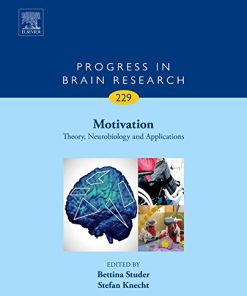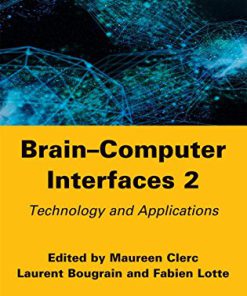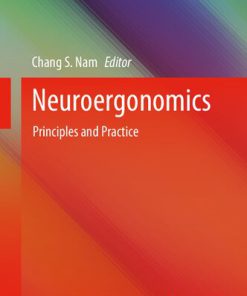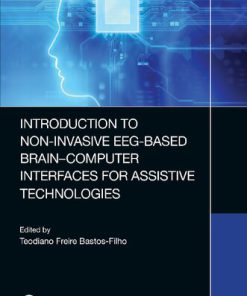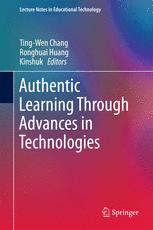Brain Computer Interfaces Handbook Technological and Theoretical Advances 1st Edition by Chang Nam, Anton Nijholt, Fabien Lotte 1351231930 9781351231930
$50.00 Original price was: $50.00.$25.00Current price is: $25.00.
Brain-Computer Interfaces Handbook: Technological and Theoretical Advances 1st Edition by Chang S. Nam, Anton Nijholt, Fabien Lotte – Ebook PDF Instant Download/DeliveryISBN: 1351231930, 9781351231930
Full download Brain-Computer Interfaces Handbook: Technological and Theoretical Advances 1st Edition after payment.
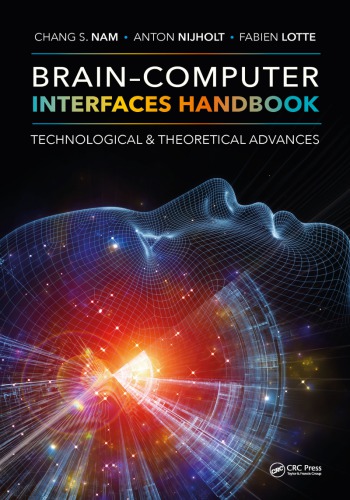
Product details:
ISBN-10 : 1351231930
ISBN-13 : 9781351231930
Author: Chang S. Nam, Anton Nijholt, Fabien Lotte
Brain–Computer Interfaces Handbook: Technological and Theoretical Advances provides a tutorial and an overview of the rich and multi-faceted world of Brain–Computer Interfaces (BCIs). The authors supply readers with a contemporary presentation of fundamentals, theories, and diverse applications of BCI, creating a valuable resource for anyone involved with the improvement of people’s lives by replacing, restoring, improving, supplementing or enhancing natural output from the central nervous system. It is a useful guide for readers interested in understanding how neural bases for cognitive and sensory functions, such as seeing, hearing, and remembering, relate to real-world technologies. More precisely, this handbook details clinical, therapeutic and human-computer interfaces applications of BCI and various aspects of human cognition and behavior such as perception, affect, and action. It overviews the different methods and techniques used in acquiring and pre-processing brain signals, extracting features, and classifying users’ mental states and intentions. Various theories, models, and empirical findings regarding the ways in which the human brain interfaces with external systems and environments using BCI are also explored. The handbook concludes by engaging ethical considerations, open questions, and challenges that continue to face brain–computer interface research. Features an in-depth look at the different methods and techniques used in acquiring and pre-processing brain signals, extracting features, and classifying the user’s intention Covers various theories, models, and empirical findings regarding ways in which the human brain can interface with the systems or external environments Presents applications of BCI technology to understand various aspects of human cognition and behavior such as perception, affect, action, and more Includes clinical trials and individual case studies of the experimental therapeutic applications of BCI Provides human factors and human-computer interface concerns in the design, development, and evaluation of BCIs Overall, this handbook provides a synopsis of key technological and theoretical advances that are directly applicable to brain–computer interfacing technologies and can be readily understood and applied by individuals with no formal training in BCI research and development.
Brain-Computer Interfaces Handbook: Technological and Theoretical Advances 1st table of contents:
Part I Brain–Computer Interface Applications
Section A Brain–Computer Interfaces Introduction
Chapter 1 Brain–Computer InterfaceAn Emerging Interaction Technology
1.1 Introduction
1.1.1 How Does a BCI Work?
1.1.2 How Can BCIs Be Categorized?
1.2 Signal Acquisition Methods
1.2.1 Noninvasive Recording Methods
1.2.1.1 Electroencephalography
1.2.1.2 Magnetoencephalography
1.2.1.3 Functional Magnetic Resonance Imaging
1.2.1.4 Functional Near-Infrared Spectroscopy
1.2.1.5 Positron Emission Tomography
1.2.2 Invasive Recording Methods
1.2.2.1 Electrocorticography
1.2.2.2 Intracortical Neuron Recording
1.2.3 Brain Signal Patterns for BCI Operation
1.2.3.1 P300 ERPs
1.2.3.2 Steady-State Evoked Potentials
1.2.3.3 Sensorimotor Rhythms
1.2.3.4 Slow Cortical Potentials
1.3 Improving Signal Quality and Feature Extraction Methods
1.3.1 Removing Noisy Signals and Artifacts
1.3.2 Spatial Filtering
1.3.2.1 Referencing Methods
1.3.2.1.1 Bipolar Reference
1.3.2.1.2 Surface Laplacian Reference
1.3.2.1.3 Common Average Reference
1.3.2.2 Data-Dependent Spatial Filtering
1.3.2.2.1 Principal Component Analysis
1.3.2.2.2 Independent Component Analysis
1.3.2.2.3 Common Spatial Patterns
1.3.3 Feature Extraction: SSVEPs
1.4 Feature Classification Methods
1.4.1 Linear Classifiers
1.4.1.1 Linear Discriminant Analysis
1.4.1.2 Support Vector Machine
1.4.2 Artificial Neural Network Classifiers
1.4.2.1 Multilayer Perceptron
1.4.2.2 Other ANN Architectures
1.4.3 Hidden Markov Model Classifiers
1.5 Example BCI Applications
1.5.1 P300-Based BCIs
1.5.1.1 Communication Applications
1.5.1.2 Control Applications
1.5.2 SSVEP-Based BCIs
1.5.2.1 Communication
1.5.2.2 Control
1.5.3 ERD/ERS-Based BCIs
1.5.3.1 Communication
1.5.3.2 Control
1.6 Summary
Acknowledgments
References
Chapter 2 Facilitating the Integration of Modern Neuroscience into Noninvasive BCIs
2.1 Introduction
2.2 Mapping Noninvasive Signals to the Brain
2.3 Application: Applying Neuroscience to Improve Classification Accuracy
2.4 Application: Transfer Learning
2.5 Conclusions and Future Directions
Acknowledgments
References
Chapter 3 Passive Brain–Computer InterfacesA Perspective on Increased Interactivity
3.1 Passive Brain–Computer Interfaces
3.2 Mental State Assessment
3.2.1 Introduction
3.2.2 Examples from the Literature
3.2.3 Reflection
3.3 Open-Loop Adaptation
3.3.1 Introduction
3.3.2 Examples from the Literature
3.3.3 Reflection
3.4 Closed-Loop Adaptation
3.4.1 Introduction
3.4.2 Examples from the Literature
3.4.3 Reflection
3.5 Automated Adaptation
3.5.1 Introduction
3.5.2 Examples from the Literature
3.5.3 Reflection
3.6 Summary and Conclusion
Acknowledgments
References
Section B Therapeutic Applications
Chapter 4 Brain–Computer Interfaces for Motor Rehabilitation, Assessment of Consciousness, and Communication
4.1 Introduction
4.2 Patients with DOC
4.3 Stroke Patients
4.4 Conclusion
References
Chapter 5 Therapeutic Applications of BCI Technologies
5.1 Introduction
5.2 Current BCI Rehabilitation Paradigms
5.3 Brief Overview of Research Findings
5.4 Discussion
5.5 Summary
References
Chapter 6 Advances in Neuroprosthetics Past, Present, and Future
6.1 Introduction
6.2 Evolutionary Neurobiology, Toolmaking, and Brain–Computer Interfaces
6.3 Current Neuroprosthetics
6.3.1 Neurological and Neurologically Related Disorders
6.3.2 Motor Control and Movement
6.3.3 Sensory Neuroprosthetics
6.3.3.1 Auditory
6.3.3.2 Ocular
6.3.3.3 Somatosensory
6.3.4 Memory, Cognition, and Volition
6.4 Microscale Brain–Computer Interfaces
6.5 Future Neuroprosthetics
6.5.1 Intelligent, Biomimetic, and Neurobiohybrid Neuroprosthetics
6.5.2 Nanobiotechnology
6.5.3 Synthetic Biology
6.5.4 Bionanoprotonics
6.6 Invasive versus Noninvasive Neuroprosthetics
6.7 Security and Standards
6.7.1 Information Security
6.7.2 Standards
6.8 Conclusion
References
Chapter 7 Design and Customization of SSVEP-Based BCI Applications Aimed for Elderly People
7.1 Introduction
7.2 SSVEP Paradigm
7.3 Customization of SSVEP Parameters
7.3.1 Stimulation Frequencies
7.3.2 Number of Classes
7.3.3 Time Windows
7.4 Design of the GUI
7.5 Summary
References
Section C Affective and Artistic Brain–Computer Interfaces
Chapter 8 Affective Brain–Computer Interfacing and Methods for Affective State Detection
8.1 Introduction
8.2 Affective States
8.3 Affective State Reporting
8.3.1 Discrete Methods
8.3.2 Continuous Methods
8.4 Affective State Detection
8.5 Affective BCIs
8.5.1 Categories of aBCI
8.5.2 Use of Affect in aBCI
8.6 Case Study: An Affective BCMI
8.7 Guide for Developing aBCIs
8.8 Summary
References
Chapter 9 Toward Practical BCI Solutions for Entertainment and Art Performance
9.1 Introduction: Practical BCI Solutions for Masses
9.2 Technology Required for Practical BCI Solutions
9.2.1 Convenient EEG Electrodes
9.2.2 Active Sensors
9.2.3 Electronic Design
9.2.4 EEG Headset
9.2.5 Data Processing
9.2.6 Actuation/Information Communication
9.3 Competitive Toy Car Racing Using Motor Imagery BCI
9.3.1 Study Population
9.3.2 Experimental Protocol
9.3.2.1 Cue-Based Measurements
9.3.2.2 Self-Paced Measurements
9.3.3 Data Analysis
9.3.3.1 Preprocessing
9.3.3.2 Feature Extraction and Classification
9.3.3.3 Evaluation
9.3.4 Results
9.3.5 Application Example
9.4 Enriching Performance of a Juggler by Brain and Body Sonification
9.4.1 Study Population
9.4.2 Experimental Protocol
9.4.3 Data Analysis
9.4.3.1 Preprocessing
9.4.3.2 Data Analysis
9.4.4 Results
9.4.5 Application Example
9.5 Monitoring Vigilance in Children during Entertainment and Learning
9.5.1 Study Population
9.5.2 Experimental Protocol
9.5.3 Data Analysis
9.5.3.1 Preprocessing
9.5.3.2 Data Analysis
9.5.4 Results
9.5.5 Application Example
9.6 Discussion
Acknowledgments
References
Chapter 10 BCI for Music MakingThen, Now, and Next
10.1 Introduction
10.2 BCI and Music, an Overview
10.3 Historical Approaches
10.4 Current: Hybrid Systems and Affective State Control
10.5 Next Steps
References
Section D BCI Control of Entertainment and Multimedia
Chapter 11 BCI and Games: Playful, Experience-Oriented Learning by Vivid Feedback?
11.1 Overview
11.2 Need for New Feedback Designs?
11.3 Summary of BCI/NF Studies Using Games as Feedback
11.4 Potential Value of Using Game-Like FB
11.4.1 Motivation and Interest
11.4.2 Flow, Immersion, and Presence
11.4.3 Attract Users’ Attention and Reduce Mind Wandering
11.4.4 Intuitive Feedback and Interactions
11.4.5 Activating the Mirror Neuron System
11.4.6 Transfer to Real-World Behavior
11.4.7 Increasing BCI/NF Performance and Consequently Its Outcome
11.5 Drawbacks—Lack of Evaluation of Effects
11.6 Conclusion
Acknowledgments
References
Chapter 12 Brain–Computer Interfaces for Mediating Interaction in Virtual and Augmented Reality
12.1 Virtual and Augmented Reality
12.1.1 What Makes VR/AR Interesting for Research?
12.1.2 Measures of VR/AR Fidelity: Immersion and Presence
12.1.3 How VR/AR Setups Work
12.2 General Research Applications for VR/AR
12.3 VR and BCIs
12.3.1 Control and Exploration
12.3.2 Therapeutic Intervention
12.4 AR and BCIs
12.5 Example Architecture for BCI/VR Setup
12.6 Validation of Example Architecture
12.6.1 Technical Validation—Latency and Jitter of Processing
12.6.2 Experimental Validation
12.7 Limitations of VR and AR in the Context of BCI
12.8 Future Developments
12.8.1 Novel Interfaces between User and VR/AR
12.8.2 Novel Paradigms—Opportunistic Sensing
12.9 Conclusion
Acknowledgments
References
Chapter 13 Brain–Computer Interfaces and HapticsA Literature Review
13.1 Introduction
13.1.1 Introduction to Haptics
13.1.1.1 Cutaneous or Tactile Sensing
13.1.2 The Potential of Haptics for HCI and BCI
13.2 Haptic Feedback in Active BCIs
13.2.1 Haptic Feedback in Active BCIs in a Nutshell
13.3 Haptic Cues in Reactive BCIs
13.3.1 ERP-Based BCIs
13.3.1.1 Tactile ERP-Based Reactive BCIs in a Nutshell
13.3.2 SSSEP-Based BCIs
13.3.2.1 SSSEP-Based BCIs in a Nutshell
13.3.3 Other BCI Paradigms Including Haptics
13.4 Conclusions and Recommendations
References
Part II Signal Acquisition and Open Source Platform in BCI
Chapter 14 Utilizing Subdermal Electrodes as a Noninvasive Alternative for Motor-Based BCIs
14.1 Introduction
14.2 Materials and Methods
14.2.1 Subjects
14.2.2 Electrodes and Electrode Placement
14.2.3 Task
14.2.4 Data Acquisition
14.2.5 Data Preprocessing
14.2.5.1 Comparing Mu, Beta, and High Gamma Band Power Changes in Subdermal and Surface Electrode Recordings
14.2.5.2 Comparing Magnitude Squared Coherence between Subdermal and Surface Electrode Recordings
14.3 Results
14.3.1 Comparison of Low- and High-Frequency Band Power Changes in Subdermal and Surface Electrode Recordings
14.3.2 Comparison of Magnitude Squared Coherence between Subdermal and Surface Electrode Recordings
14.4 Discussion
References
Chapter 15 Validation of Neurotrophic Electrode Long-Term Recordings in Human Cortex
15.1 Introduction
15.2 Methods
15.3 Results
15.4 Four Years after Implantation
15.5 Nine Years after Implantation
15.6 Functional Studies at Year 9
15.7 Discussion
References
Glossary
Acknowledgments
Institutional Review Board Approval
Federal Drug Administration Approval
Conflicts of Interest
Chapter 16 ECoG-Based BCIs
16.1 Introduction
16.2 ECoG Signal Acquisition
16.3 ECoG Signal Physiology
16.4 Current ECoG-Based BCIs
16.4.1 ECoG BCIs for Control
16.4.2 ECoG BCIs for Communication
16.4.3 ECoG BCIs for Neuromodulation
16.5 Current Implantable Devices
16.6 Open Questions and Directions for Further Research
16.7 Summary
Acknowledgment
References
Chapter 17 BCI Software
17.1 Introduction
17.1.1 Technical Demands
17.1.2 Scope of Investigation
17.2 Implementation
17.2.1 BCI Software Platforms Using Commercial High-Level Platforms
17.2.1.1 Matlab
17.2.1.2 Simulink
17.2.1.3 LabVIEW
17.2.2 Self-Contained BCI Software Platforms
17.2.2.1 OpenViBE
17.2.2.2 BCI2000
17.3 Impact of BCI Software
17.4 Summary and Conclusions
References
Part III Signal Processing, Feature Extraction, and Classification in BCI
Chapter 18 Gentle Introduction to Signal Processing and Classification for Single-Trial EEG Analysis
18.1 Univariate Features and the Amplitude Threshold Criterion
18.2 From Uni- to Multivariate Features
18.3 Multivariate Approach to Classification of Single-Trial EEG
18.4 Introduction to Discriminative Features of Brain Activity—Signal and Noise
18.4.1 Modulations of ERPs
18.4.2 Amplitude Modulations of Brain Rhythms
18.5 Introduction to Linear Classification
18.5.1 Motivation—Nearest Centroid Classifier
18.5.2 Linear Discriminant Analysis
18.5.3 Interlude: Gaussian Distributions and Related Transformations
18.5.4 Relation of LDA to NCC, Whitening, and Mahalanobis Distance
18.5.5 Remark on the Assumptions of LDA
18.5.6 LDA with Shrinkage of the Covariance Matrix
18.5.7 Other Classification Methods
18.6 Feature Extraction
18.6.1 Guideline for Transient Activity: ERP and LRP
18.6.2 Guideline for Oscillatory Brain Activity
18.6.3 Feature Extraction: CSP Analysis
18.6.4 Feature Extraction: CCA
18.7 Appendix: Formalization of CSP as a Two-Step Procedure
References
Chapter 19 Riemannian Classification for SSVEP-Based BCIOffline versus Online Implementations
19.1 Introduction
19.2 A Review of SSVEP-Based BCI
19.2.1 Steady-State Visually Evoked Potentials
19.2.2 Online and Offline Implementations for BCI
19.3 Classifying SSVEP Signals
19.3.1 Notations
19.3.2 Classification Using Canonical Correlation
19.3.3 Classification Using Riemannian Geometry
19.4 Riemannian Geometry
19.4.1 Geometry of Covariance Matrices
19.4.2 Estimators of Covariance Matrices
19.4.3 Distances and Means
19.4.4 Minimum Distance to Mean Classifier
19.4.5 MDM for SSVEP
19.4.6 Online MDM
19.5 Experimental Evaluation on SSVEP Data Set
19.5.1 SSVEP Data Set Description
19.5.2 Evaluation of the Covariance Estimators
19.5.3 Offline Classification of SSVEP
19.5.4 Online Classification of SSVEP
19.6 Conclusions
References
Chapter 20 The Fundamentals of Signal Processing for Evoked Potential BCIs:A Guided Tutorial
20.1 Introduction
20.2 Four-Class P300 Oddball
20.2.1 Data Collection
20.2.2 Data Preprocessing
20.2.3 Data Segmentation and Feature Extraction
20.2.4 Classifier Training
20.2.5 Classification
20.2.6 Considerations
20.3 n-Class SSVEP
20.3.1 Data Collection
20.3.2 Data Preprocessing
20.3.3 Data Segmentation and Classification
20.3.4 Considerations
Acknowledgments
References
Chapter 21 Bayesian Learning for EEG Analysis
21.1 Introduction
21.2 Equivalence between LDA and LSR
21.3 Maximum Likelihood and Regularized Least Squares
21.4 Bayesian Learning
21.4.1 Bayesian Discriminant Analysis
21.4.2 Sparse Bayesian Learning
21.5 Experimental Study
21.5.1 ERP Data Set
21.5.1.1 Data Description
21.5.1.2 Performance Evaluation
21.5.1.3 Results
21.5.2 SMR Data Set
21.5.2.1 Data Description
21.5.2.2 Performance Evaluation
21.5.2.3 Results
21.6 Discussion
21.7 Conclusions
References
Chapter 22 Transfer Learning for BCIs
22.1 Introduction: Why Do We Need to Worry about Session Transfer?
22.1.1 Transfer Learning
22.1.2 Mathematical Notation
22.2 Approaches in the Feature Space
22.2.1 Nonlinear Representations
22.2.2 Riemannian Classification in BCIs
22.2.3 Regularized Common Spatial Patterns
22.3 Model Space Learning: A Statistical Learning Framework
22.3.1 MTL in Regression Problems
22.3.2 MTL in Classification Problems
22.3.3 Calibration-Free Decoding and Model Adaptation
22.3.4 Dimensionality Reduction in EEG: Feature Decomposition
22.3.5 Which Approach Should I Use?
22.4 Conclusions
References
Part IV Brain–Computer Interface Paradigms
Chapter 23 A Step-by-Step Tutorial for a Motor Imagery–Based BCI
23.1 Introduction: Motor Imagery–Based BCI
23.2 Training Session
23.2.1 Recording MI Data
23.2.1.1 Recording Device and Software
23.2.1.2 Subjects
23.2.1.3 Environment
23.2.1.4 Experimental Paradigm
23.2.1.5 MI Instructions
23.2.1.6 Questionnaire
23.2.1.7 Discussions
23.2.1.7.1 Recording Software and Device
23.2.1.7.2 Subjects
23.2.1.7.3 Environment
23.2.1.7.4 Experimental Paradigm
23.2.1.7.5 MI Instructions
23.2.1.7.6 Questionnaire
23.2.2 Training Algorithms and Offline Analysis
23.2.2.1 Preprocessing
23.2.2.1.1 Offline Analysis
23.2.2.3 Feature Extraction
23.2.2.4 Classification
23.2.2.5 Discussion
23.2.2.5.1 Preprocessing
23.2.2.5.2 Offline Analysis
23.2.2.5.3 Feature Extraction
23.2.2.5.4 Classification
23.3 Testing Session
23.3.1 Online Experiment
23.3.2 Discussion
23.4 Summary
Acknowledgments
References
Chapter 24 Eye Gaze Collaboration with Brain–Computer InterfacesUsing Both Modalities for More Robust Interaction
24.1 Introduction
24.2 Overview of Current SSVEP and ET Advances
24.2.1 SSVEP
24.2.2 hBCI with Eye Gaze
24.3 Eye Gaze and SSVEP hBCI
24.3.1 Concepts for the Inclusion of ET into the hBCI
24.3.2 Visual Interface Application Design
24.3.3 The ET Component
24.3.4 The SSVEP BCI Component
24.3.5 The hBCI Architecture
24.3.6 Experimental Protocol
24.3.7 Postprocessing
24.4 Discussion and Conclusions
References
Chapter 25 Designing a BCI Stimulus Presentation Paradigm Using a Performance-Based Approach
25.1 Introduction
25.2 The Performance-Based Paradigm
25.2.1 Bayesian DS Algorithm
25.2.2 Performance-Based Parameters
25.2.3 Codebook Development
25.3 Methods
25.3.1 BCI Implementation
25.3.2 P300 Speller Task
25.4 Results
25.5 Discussion and Future Work
Acknowledgments
List of Abbreviations
References
Chapter 26 Issues and Challenges in Designing P300 and SSVEP Paradigms
26.1 Introduction
26.2 Overview of Visual Paradigms
26.3 P300 Paradigms
26.4 SSVEP Paradigms
26.5 P300 and SSVEP Detection
26.6 Challenges in Paradigm Design
26.6.1 Crowding Effect
26.6.2 Adjacency Problem
26.6.3 Repetition Blindness
26.6.4 Fatigue
26.6.5 User Comfortability
26.6.6 User Training
26.6.7 Hardware Capacity
26.7 Paradigm and Efficiency
26.8 Paradigm Dependence of BCI Applications
26.9 Hybrid SSVEP–P300 Paradigm
26.10 Evolvement of New BCI Applications
26.11 Conclusion
References
Chapter 27 Hybrid Brain–Computer Interfaces and Their Applications
27.1 Introduction
27.2 Hybrid BCIs Based on Multibrain Patterns
27.2.1 P300-and-SSVEP–Based BCIs
27.2.1.1 P300-and-SSVEP–Based BCI Spellers
27.2.1.2 P300-and-SSVEP–Based Brain Switch
27.2.2 MI-and-SSVEP–Based BCIs
27.2.2.1 MI-and-SSVEP–Based Orthosis Control
27.2.2.2 MI-and-SSVEP–Based MI Training
27.2.3 MI-and-P300–Based BCIs
27.2.3.1 An MI-and-P300–Based BCI Mouse
27.2.3.2 MI-and-P300–Based Wheelchair Control
27.3 Multisensory Hybrid BCIs
27.3.1 Audio-Visual P300 BCIs
27.3.2 Audio-Tactile P300 BCIs
27.4 Hybrid BCIs Based on Multiple Signals
27.4.1 EEG-and-EMG–Based BCIs
27.4.2 EEG-and-EOG–Based BCIs
27.5 Hybrid BCIs Based on Multiple Intelligent Techniques
27.5.1 An Intelligent Wheelchair Based on a BCI and an Autonomous Navigation System
27.5.2 A Rehabilitative System Based on a BCI and an Intelligent Robot
27.6 Discussions and Conclusion
Acknowledgments
References
Chapter 28 Augmenting Attention with Brain–Computer Interfaces
28.1 Introduction
28.2 Neuroscience of Attention
28.3 Emergence of Attention-Based BCIs
28.4 Neural Features for Attention-Based BCIs
28.4.1 Importance of Feature Selection
28.4.2 Neural Oscillations
28.4.3 Event-Related Potentials
28.4.4 Steady-State Visual Evoked Potentials
28.5 Future Directions
28.6 Conclusions
References
Part V Human Factors, Design, and Evaluation in BCI
Chapter 29 Toward Usability Evaluation for Brain–Computer Interfaces
29.1 Introduction
29.2 Review Method
29.2.1 Eligibility Criteria
29.2.2 Study Selection
29.2.3 Usability Framework
29.3 Results
29.3.1 User Characteristics
29.3.2 Task Characteristics
29.3.3 Environment Characteristics
29.3.4 Technology Characteristics
29.3.5 Method Characteristics
29.3.6 Measurement Characteristics
29.4 Recommendations
29.5 Conclusion
References
Chapter 30 Why User-Centered Design Is Relevant for Brain–Computer Interfacing and How It Can Be Implemented in Study Protocols
30.1 For Who Is This Chapter Most Relevant?
30.2 The Relevance of UCD
30.3 What Is UCD?
30.4 UCD Realized in BCI Applications
30.5 User-Oriented BCI Applications
30.6 The Role of Evaluation
30.7 User Involvement
30.8 Why the UCD Is Not Implemented in Applied BCI Research—Some Hypotheses
30.9 Do-It-Yourself UCD and Evaluation—Getting Prepared
30.10 Final Remarks
References
Chapter 31 A Generic Framework for Adaptive EEG-Based BCI Training and Operation
31.1 Introduction
31.2 Adaptive BCI Systems—Motivations and Principles
31.2.1 Reasons for Adaptation
31.2.1.1 Causes of Signal Variability
31.2.2 Main Principles of Adaptation
31.2.2.1 Machine Learning
31.2.2.2 Human Learning
31.3 Framework
31.3.1 The System Pipeline
31.3.1.1 Literature Review on Adaptive Signal Processing/Machine Learning
31.3.1.1.1 Adaptive Feature Extraction
31.3.1.1.2 Adaptive Classifiers
31.3.1.1.3 Fully Adaptive Signal Processing
31.3.1.1.4 Adaptive Decision Methods
31.3.2 The User and the Task Model
31.3.2.1 User Model
31.3.2.1.1 A Brief Literature Review of “Adaptive Methods” Related to the User Model
31.3.2.2 Task Model
31.3.2.2.1 A Brief Literature Review of Adaptive Methods Related to the Task Model
31.3.3 Machine Output
31.3.3.1 Feedback
31.3.3.2 Instructions and Stimuli
31.3.4 Conducting Adaptation with the Conductor
31.4 Perspectives and Challenges
31.5 Conclusion
Acknowledgment
References
Chapter 32 Mind the Traps! Design Guidelines for Rigorous BCI Experiments
32.1 Introduction
32.2 Acquisition of the Signals
32.2.1 How to Choose the Appropriate Sensor Type, Location, and Number Depending on What We Want to Measure
32.2.2 What Can We Infer from the Activation of One Electrode? Concept of Spatial Resolution
32.2.3 How Muscular Activity Can Interfere with EEG Activity and Why It Should Be Controlled for to Avoid Confounds
32.2.4 What Kinds of Mental States Can Be Used?
32.3 Data Processing
32.3.1 Which Classifier Can We Use Depending on the Distribution of the Data?
32.3.2 Why Is It Important to Separate the Training Data Set from the Testing Data Set?
32.3.3 How to Determine the Chance Level for the Classified Data
32.3.4 To What Extent Can Commercial Algorithms Be Trusted?
32.3.5 How to Determine the Relevance of Neurophysiological Markers
32.3.6 Why Is It Important to Correct for Multiple Comparisons?
32.4 Experimental Design and the User Component
32.4.1 What to Have in Mind When Designing a New BCI Experiment
32.4.2 Why and How to Have a Good Control Group?
32.4.3 How to Avoid Biases: Concepts of Counterbalancing, Sham Control, Double Blindness, and Randomization
32.4.4 How to Select the Appropriate Statistical Tests
32.5 Summary and Conclusion
Acknowledgments
References
Chapter 33 Evaluation and Performance Assessment of the Brain–Computer Interface System
33.1 Introduction
33.2 General Framework
33.3 Discrete BCI
33.3.1 Binary Classification Accuracy versus Task Accuracy
33.3.1.1 Confusion Matrix
33.3.1.2 Binomial Models for Accuracy
33.3.2 Information Gain
33.3.2.1 Information Transfer Rate
33.3.2.2 Rate of Information Gain
33.3.3 BCI Utility
33.3.3.1 Utility for P300 Speller
33.3.4 Data Scarcity and Predicted Accuracy
33.3.4.1 Projected Accuracy Metric
33.3.4.2 Classifier-Based Latency Estimation
33.4 Continuous BCI
33.4.1 Fitts’s Law and Information Theory
33.4.1.1 Shannon’s Theory
33.4.1.2 Fitts’s Law
33.4.2 Shannon–Welford Model
33.5 Discussion
References
Part VI Emerging Issues and Future BCIs
Chapter 34 Privacy and Ethics in Brain–Computer Interface Research
34.1 Introduction: Privacy and BCI
34.2 BCI and Definitions of Privacy
34.3 Mental Privacy
34.4 BCI and Privacy Opportunity
34.5 Privacy and BCI Big Data
34.6 Conclusion
References
Chapter 35 Associative Plasticity Induced by a Brain–Computer Interface Based on Movement-Related Cortical Potentials
35.1 Introduction
35.2 The Movement-Related Cortical Potential
35.2.1 MRCPs during Sensorimotor Behavior
35.2.1.1 Type of Movement
35.2.1.2 Speed/Velocity of Movement
35.2.1.3 Force
35.2.2 MRCP during Motor Imagery
35.2.3 Detection of the MRCP during Motor Tasks and Imagery
35.2.4 Detection of the MRCP during Gait
35.3 MRCP-Based Associative BCIs
35.3.1 Effects of Type of Neurofeedback as Part of the Associative BCI
35.3.2 Potential and Challenges of MRCP-Based Associative BCI
References
Chapter 36 Past and Future of Multi-Mind Brain–Computer Interfaces
36.1 Introduction
36.2 Theoretical Aspects of Multi-Mind BCIs
36.2.1 History of Multi-Mind BCIs
36.2.2 Implementing a Collective Brain
36.2.3 How Many Minds Are Needed?
36.2.4 Influence of Participant Similarity When Forming Groups
36.2.5 Challenges
36.3 Applications
36.3.1 Communication
36.3.2 Control of External Devices
36.3.3 Video Games
36.3.4 Target Detection and Decision Making
36.3.5 Music
36.4 Tutorial
36.4.1 Application
36.4.2 Number of Users
36.4.3 Real-Time Requirement
36.4.4 Operation Mode
36.4.5 Fusion of Brain Signals
36.5 Future Directions
References
Chapter 37 Bidirectional Neural Interfaces
37.1 Introduction
37.2 Types of Neural Interfaces
37.3 Neural Recordings
37.4 Decoding Neural Signals
37.5 Motor Neural Interfaces
37.6 Artificial Sensation
37.7 Bidirectional Neural Interfaces
37.8 Futuristic Ideas
37.9 Concluding Remarks
References
Chapter 38 Perspectives on Brain–Computer Interfaces
38.1 Future Development
38.2 Summary
People also search for Brain-Computer Interfaces Handbook: Technological and Theoretical Advances 1st:
brain computer interfaces handbook pdf
what is brain computer interface
brain-computer interface examples
brain computer interface book
brain-computer interface laws
Tags: Brain Computer, Interfaces Handbook, Technological, Theoretical Advances, Chang Nam, Anton Nijholt, Fabien Lotte
You may also like…
History & Research
Biology and other natural sciences
Medicine - Neuroscience
Education Studies & Teaching
Authentic Learning Through Advances in Technologies 1st Edition Ting-Wen Chang
Biology and other natural sciences - Plants: Agriculture and Forestry
Mathematics






